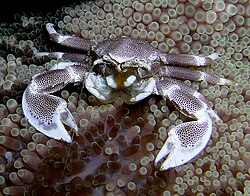| Galatheoidea Temporal range: | |
|---|---|
 | |
| Neopetrolisthes maculatus (Porcellanidae) | |
 | |
| Munidopsis tridentata (Munidopsidae) | |
| Scientific classification | |
| Domain: | Eukaryota |
| Kingdom: | Animalia |
| Phylum: | Arthropoda |
| Class: | Malacostraca |
| Order: | Decapoda |
| Suborder: | Pleocyemata |
| Infraorder: | Anomura |
| Superfamily: | Galatheoidea Samouelle, 1819 |
| Families | |
The Galatheoidea are a superfamily of decapod crustaceans comprising the porcelain crabs and some squat lobsters. Squat lobsters within the three families of the superfamily Chirostyloidea are not closely related to the squat lobsters within the Galatheoidea. [1] The fossil record of the superfamily extends back to the Middle Jurassic genus Palaeomunidopsis . [1]